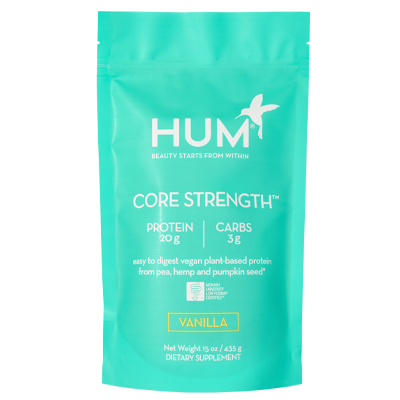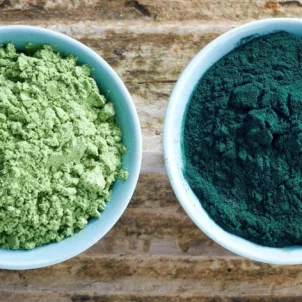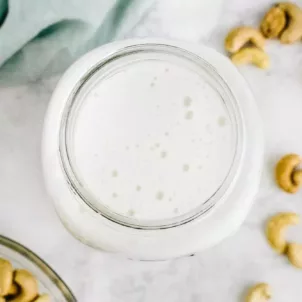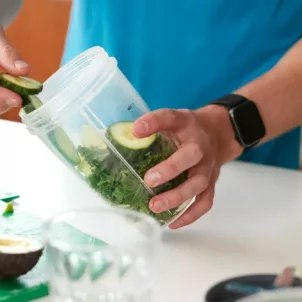THE WELLNEST • Food • Healthy Eating
The Ultimate Guide to Juicing vs. Smoothies (And How to Reap Benefits from Both)
By Shavonne Morrison, MS, RD, LD •
August 17, 2021
When it comes to juicing vs. smoothies, which one is healthier for you? Shavonne Morrison, MS, RD, LD, details the benefits and drawbacks to each before sharing her final verdict.
One of the most convenient ways to incorporate the benefits of fruits and vegetables into your diet is to put them in the form of a drink. It’s easy to do, allows you to experiment with flavors to your liking, and you can take it on the go.
Two ways of getting these benefits include juicing fresh produce or blending it up into a smoothie. But is juicing better than smoothies? And how exactly do they differ?
While each has its own share of health benefits, there are some key differences to note. Understanding the pros and cons of juicing and smoothies will help you decide which is best for your goals and concerns.
Keep reading for all the details on juicing and smoothies, including tips for making both.
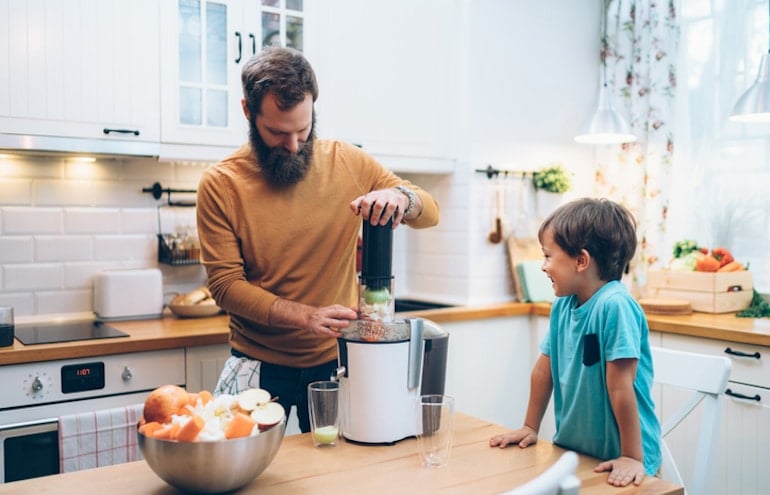




downsides AND benefits of juicing
Juicing entails taking whole or peeled fruits and vegetables and processing them through a mechanism that extracts the liquid. It’s a popular way to get a quick nutrition boost, yet it’s also a component of many fad diets and “cleanses.” And while we don’t recommend an all-juice cleanse—or any potentially dangerous fad diets, for that matter—juicing does offer worthy benefits.benefits
Fruit juices that are 100 percent juice are considered to be a serving of fruit by the USDA. The USDA recommends that adults get two to three cups of fruit daily, so juicing can help you meet this requirement. Juices are full of vitamins, minerals, and antioxidants. These nutrients are important for many bodily functions to maintain optimal long-term health. In addition, juices can be lower in sugar compared to smoothies—but this varies widely depending on ingredients. For example, juice containing leafy greens and an apple will typically have less sugar than a banana-based fruit smoothie—even if the smoothie has other ingredients such as nut butter, seeds, or protein powder to make it more balanced. The benefit of juices having less sugar compared to smoothies is that they still offer vitamins and minerals while minimizing sugar intake. If one of your health goals is to reduce or eliminate sugar from your diet, juicing may be the better option for you.downsides
Since the process of juicing removes the fibrous flesh and pulp of fruit, juices lack fiber, thus presenting one of the downsides of juicing. Fiber is one of the key nutritional features of fruits and vegetables since it keeps you full for longer and can help aid digestion. Another con of juicing is that, unlike smoothies, juices can’t adequately replace meals. Although fad diets or cleanses claim may otherwise, juiced produce alone doesn’t provide enough calories, protein, carbs, or fats that your body needs. You may end up losing weight (due to a caloric deficit), but this method is neither healthy nor sustainable for weight management. Finally, the equipment necessary for juicing can be expensive. While you could theoretically squeeze the juice out of most fruits and some veggies by hand, doing so is highly impractical and would negate the convenience of this method. Juicers range in price from about $50 to upwards of $400, so, this may not be an affordable option for everyone.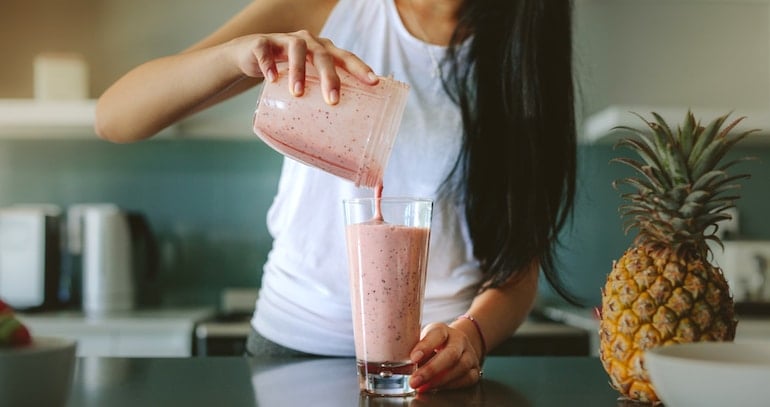
downsides and benefits of smoothies
Smoothies combine fruits, vegetables, and other nutritious add-ins like milk, protein powder, nut butter, and seeds. Smoothies come in many forms. Some (true to their name) are smooth and creamy. Others can be icy or watery, as well as sweet or “earthier” with loads of greens. You can also make smoothie bowls at home or buy them prepackaged.benefits
Two of the major benefits of smoothies are their versatility and ability to have a nutritionally balanced profile. With smoothies, you can easily add protein and healthy fats to promote fullness. Using the flesh of the fruit or vegetable also preserves the fiber, which will keep you full for longer too. With the right blend of ingredients, smoothies can be satiating and may even be able to replace a meal. (Conversely, juicing actually removes some nutritional value—namely fiber—during preparation.) Additionally, smoothies are relatively inexpensive and easy to make. You may even have a blender or food processor at home already. If not, there are many inexpensive blenders you can purchase online or in stores.downsides
When it comes to blending smoothies, ingredients can make or break their nutritional value. Unfortunately, many smoothie recipes have nearly as much sugar as sodas. To make a healthy smoothie—whether as a snack or meal replacement—balance is key. We’ll outline some specific tips on how to do this later on. For now, remember that smoothies can be healthy, just as long as they include carbs, proteins, and healthy fats. Another downside of smoothies is that they can take some experimenting to work. Sometimes a delicious smoothie can look a bit off by turning brown or gray, and it may even change color as you drink it. Not every smoothie you make will be Instagram-worthy—but that’s okay! After all, the look of a smoothie doesn’t determine its health benefits. However, if the appearance bothers you, simply collect and rotate a set of recipes. Gathering a diverse mix of smoothie recipes that you love will also benefit you by providing a wider range of nutrients.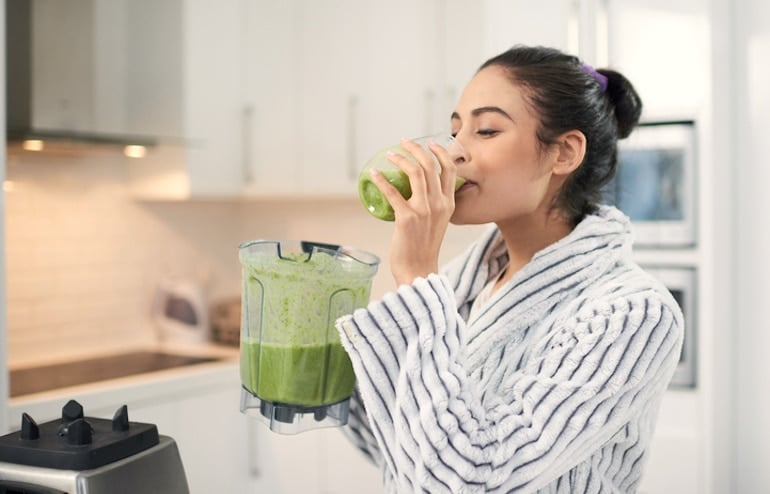
Juicing vs. Smoothies: Which is healthier?
As we saw above, there are benefits of juicing and smoothies alike. The best option for you will ultimately depend on your health goals. However, as a registered dietitian, my verdict is that smoothies are healthier than juices. I say this because it’s essential to eat balanced snacks and meals. Whether you’re trying to manage your weight or simply want more produce in your everyday eats, smoothies are typically superior because:- smoothies have fiber that juices lack
- smoothies are more satiating
- the best smoothie recipes pack a healthy balance of protein, carbs, and healthy fats
How to Make the Best Smoothies and Juices
Here are some tips to reap the greatest benefits from both types of blends.Juicing Tips
- Use fresh fruits and vegetables and be sure to wash them thoroughly before juicing.
- Add fresh ginger or turmeric for an anti-inflammatory boost.
- Incorporate veggies into your juices, such as kale, Swiss chard, carrots, and beets. While they may not seem as tasty as pure fruit juice, they offer a range of key nutrients that some fruits lack.
- Be mindful of sugar content by drinking only small portions at a time. For reference, eight ounces of 100 percent fruit juice equates to one serving of fruit. Most adults need at least two cups of fruit daily, no more than half of which should come from juices.
Smoothie Tips
- Bulk up your blend by adding plenty of protein—think nut butter, seeds, dairy or plant-based milk, spirulina, and protein powder.
- Ensure your smoothie packs a good amount of healthy fats, such as avocado, Greek yogurt, coconut oil/shavings, chia seeds, and ground flax seeds.
- Freeze fresh produce to use in future smoothie recipes. Frozen greens, bananas, and pineapples all create great texture.
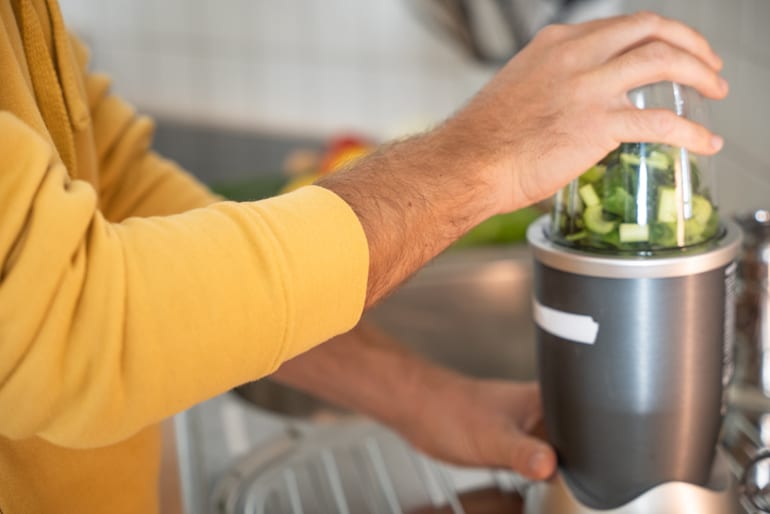
The Bottom Line
Many people don’t eat enough fruits or veggies, making liquid forms a convenient way to boost your diet. However, there are pros and cons of juicing vs. smoothies alike, so it’s important to know how to make them as healthy as possible. If you want a quick boost of nutrients without needing to replace a meal, drinking juice with a balanced meal is a good option. Yet if you want something more satiating that may also promote healthy weight management, smoothies may be your best bet. While smoothies and juices have vital nutrients, smoothies are typically better since they can boast a balanced blend of macronutrients. All things considered, you can promote better health and longevity by increasing your produce intake via the tips and considerations discussed above.More like this
